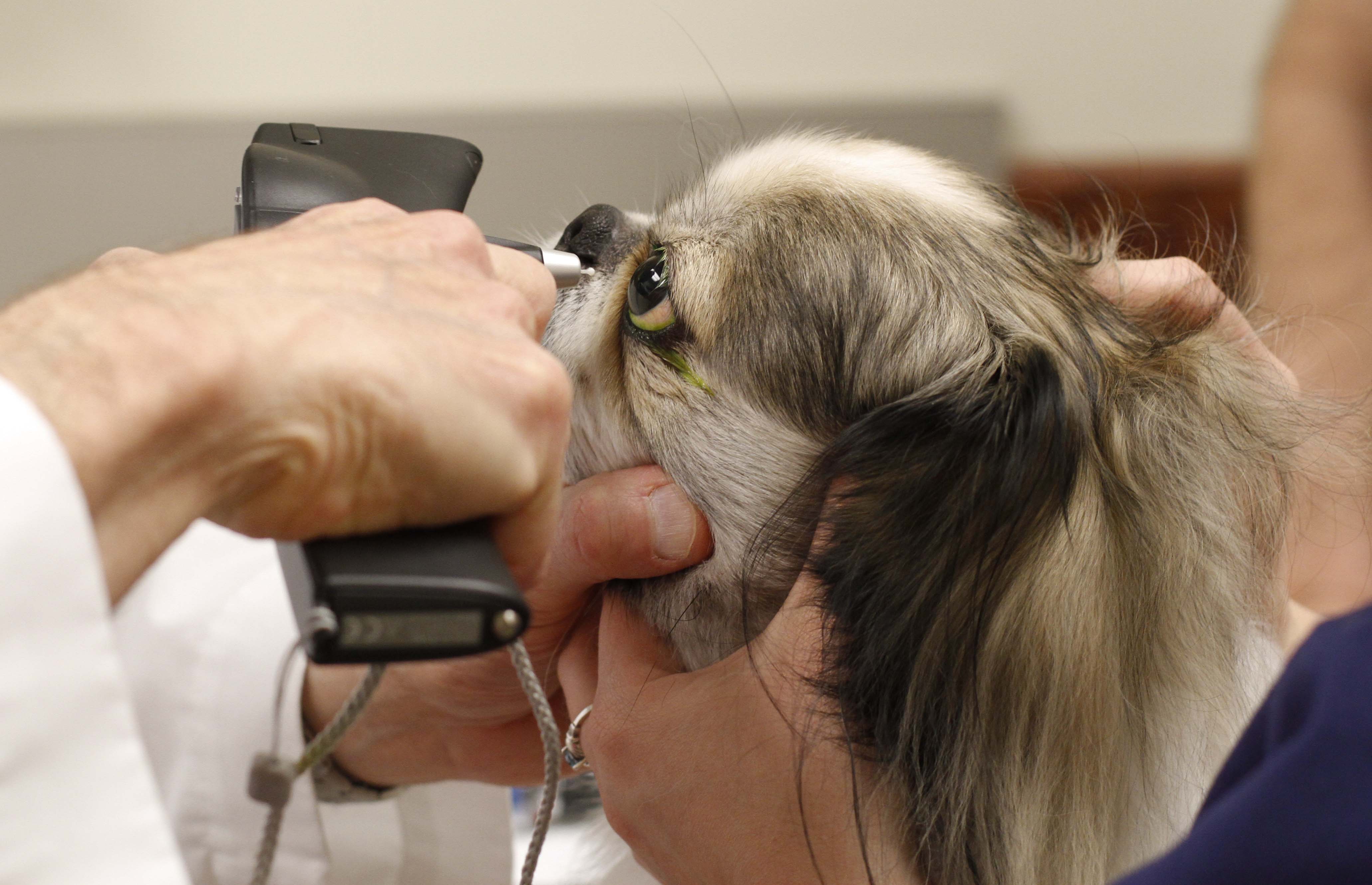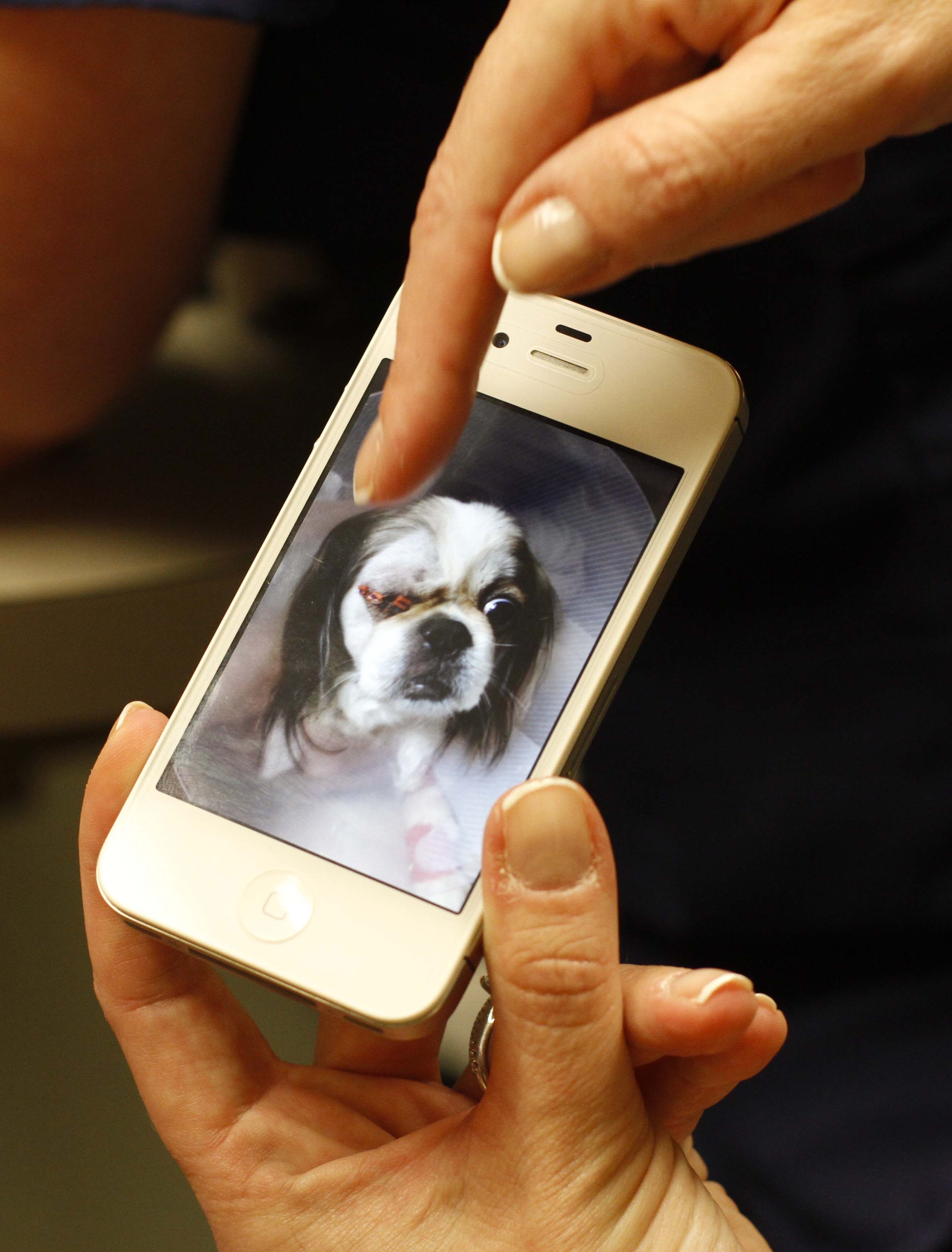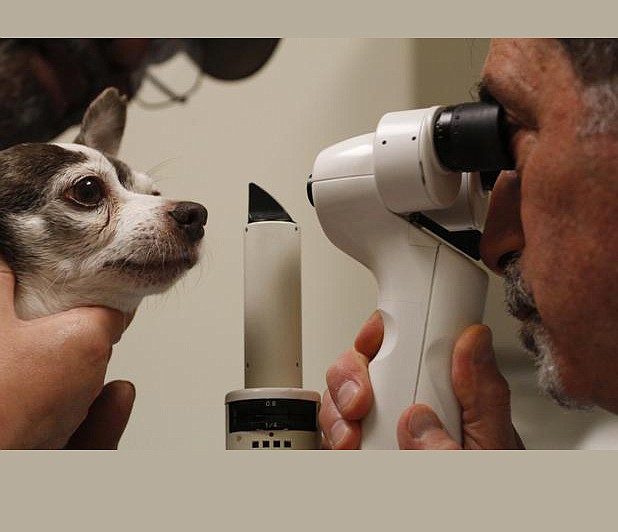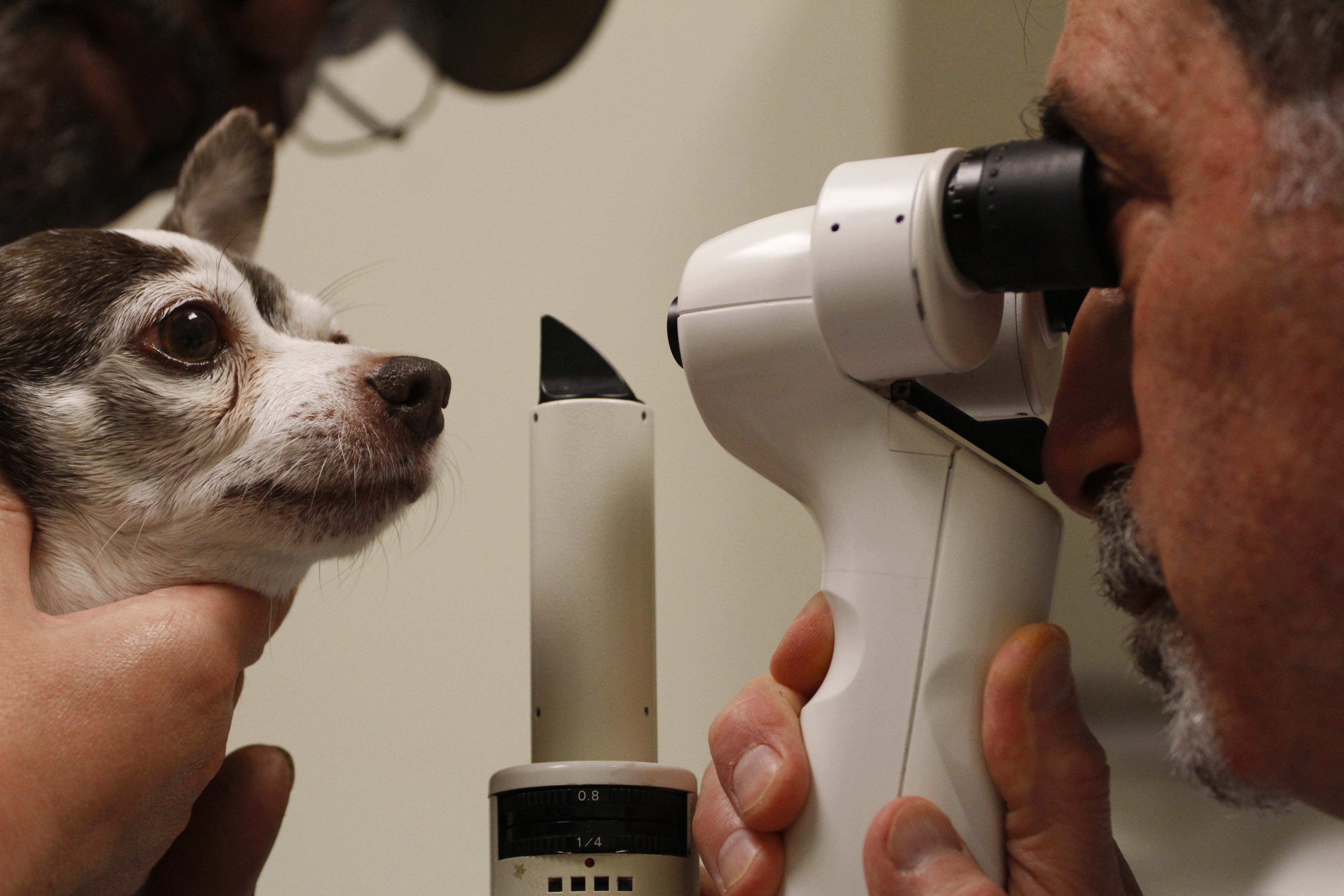EYE ON PETS: Traveling ophthalmologist treats Chattanooga area animals
Friday, January 1, 1904
 Dr. Louis Laratta, a veterinary ophthalmologist, performs a pressure test while examining "Harvey's" eyes while at the Regional Institute for Veterinary Emergencies and Referrals "RIVER" early Wednesday afternoon. Dr. Laratta travels to Chattanooga from his home in Nashville once or twice a month to examine pets.
Dr. Louis Laratta, a veterinary ophthalmologist, performs a pressure test while examining "Harvey's" eyes while at the Regional Institute for Veterinary Emergencies and Referrals "RIVER" early Wednesday afternoon. Dr. Laratta travels to Chattanooga from his home in Nashville once or twice a month to examine pets. April Pearson shows a photo of her dog "Harvey's" eyes before having surgery while at the Regional Institute for Veterinary Emergencies and Referrals "RIVER" early Wednesday afternoon. Dr. Louis Laratta, a veterinary ophthalmologist, travels to Chattanooga from his home in Nashville once or twice a month to examine pets.
April Pearson shows a photo of her dog "Harvey's" eyes before having surgery while at the Regional Institute for Veterinary Emergencies and Referrals "RIVER" early Wednesday afternoon. Dr. Louis Laratta, a veterinary ophthalmologist, travels to Chattanooga from his home in Nashville once or twice a month to examine pets.EYE PROBLEMS IN DOGSCocker spaniels, poodles, Siberian huskies, schnauzers, golden and Labrador retrievers and terriers are prone to cataracts.Basset hounds, bloodhounds, bull mastiffs, Saint Bernards, Newfoundlands and several breeds of spaniels are prone to ectropion -- when the eyelid turns outward.Pugs, bulldogs, Rottweilers, chows, Shar-Peis, boxers, springer spaniels, poodles, Great Danes and Saint Bernards are prone to entropion -- when the border of the eyelid turns inw.Pugs, Boston terriers, Shih Tzus and Pekingese are prone to exophthalmos -- abnormal protrusions of the eye.Basset hounds, cocker spaniels and chows are prone to glaucoma.Siberian huskies, cocker spaniels and Shih Tzus are prone to progressive retinal atrophy.Pekingese, pugs, Lhasa apsos, Yorkshire terriers, bloodhounds, Boston terriers, miniature poodles, miniature and standard schnauzers, English bulldogs and cocker spaniels are prone to keratoconjunctivitis (dry eye) problems.Source: Dr. Louis Laratta, About.com
Harvey was within days of losing an eye before a surgical graft helped restore his vision and save the eye.
The fact that the patient had white, brown and black fur made no difference.
When veterinary ophthalmologist Dr. Louis J. Laratta looked in on Harvey at Chattanooga's Regional Institute for Veterinary Emergencies and Referrals (RIVER) earlier this month, a happy, peppy Pekingese awaited him.
"He is coming along well," the Nashville veterinarian says. "He was a good patient."
"The situation was pretty grave when Dr. Laratta first saw him," says David Pearson, whose daughter is Harvey's owner, but the doctor "nursed him back to health and pulled him through."
Laratta, who established the first full-time veterinary specialty practice in Tennessee in 1991, sees patients in Chattanooga once a month. When a new veterinarian joins his practice in June, both will see animals twice a month at RIVER. He also has a colleague who sees patients at emergency animals clinics in Nashville and Murfreesboro.
Laratta's practice is 60 percent dogs, 20 percent cats, 10 percent horses and 10 percent other animals, he says. His Chattanooga patients approximate the same percentages but with fewer horses.
The veterinarian, who comes from Nashville with supplies and a staff of five, sees as many as 28 to 30 animals each day he's in Chattanooga, most referred by a general practitioner vet.
"The general practitioner will identify an eye problem," Laratta says. "The routine ones will heal quickly."
A specialist is consulted when the animal is not responding to treatment or when a more specialized therapy or surgery is needed.
Many of the dogs Laratta sees -- breeds such as pugs, bulldogs, Shih Tzus and Boston terriers -- are brachycephalic, or have flat faces, a normal variation in domesticated breeds. Those breeds, he says, have shallow eye sockets and, in turn, more prominent eyes. Because of the exposure, he says, they are more prone to injury.
In Harvey's case, his salivary gland was blocked, backing saliva into his right eye area, building up pressure and forcing the eye forward.
"It was difficult to treat," Laratta says. "He couldn't close his eye."
Harvey, 5, eventually had surgery in Nashville, where a graft from the white of his eye was sewn onto the lens to remedy an ulcer that had grown there.
"It's incredible what's he been through," Pearson says.
Among the other pets seen in relatively brief afternoon appointments are:
• Onyx, an 8 1/2-year-old black cat who was healing well from an ulcer that had been treated for a month with medicine;
• Black-and-white Maize, a Boston terrier, who had "come around quick" after an outpatient surgical procedure to her left eye.
• Spuds, a 13-year-old Chihuahua, who had healed from ulcers that were initially treated last fall;
"He takes care of me," says Willie Wells, owner of Spuds, "like my doctor."
Laratta has even put contact lenses on dogs to facilitate healing and on dogs "who are missing this or that" in their routines in dog agility, a sport in which a handler directs a dog through an obstacle course in a race for time and accuracy.
He's also often called upon to examine the eyes of pure-bred dogs before breeding or before pups are sold because of possible genetic defects.
Different breeds, he says, are predisposed to cataracts, glaucoma or dry eyes, each of which can be diagnosed with handheld versions of the stand-alone instruments in a human ophthalmologist's office, then treated medically or surgically.
It's all in a day's work for the doc, who wasn't satisfied with just a veterinarian degree from Michigan State University. An internship, in which he had the opportunity to do microsurgery, in which an operating microscope is used to work with the unique features of ocular tissues such as conjunctiva, cornea, and lens, intrigued him.
"I wanted to keep learning," Laratta says. "I didn't want to give up medicine or surgery. I wanted to do it all."
He also trained and served as staff ophthalmologist at Cornell University in Ithaca, N.Y., and was on the faculty of the University of Tennessee College of Veterinary Medicine in Knoxville before opening his own practice, Veterinary Ophthalmology Services in Nashville.
There, in addition to traveling to various parts of the state, he is a consultant with the Nashville Zoo.
At first blush, most pet owners believe a pet ophthalmologist is a luxury they can't afford. However, says Laratta, "we're not there to do fancy things."
"We just want to be a right hand to your regular vet," he says. "We just want to offer the best care available to take care of pets. If it's not affordable, we'll see what we can do. We're just glad we're helping [the owners] take care of it."
Contact staff writer Clint Cooper at ccooper@timesfreepress.com or 423-757-6497. Subscribe to my posts online at Facebook.com/ClintCooperCTFP.

